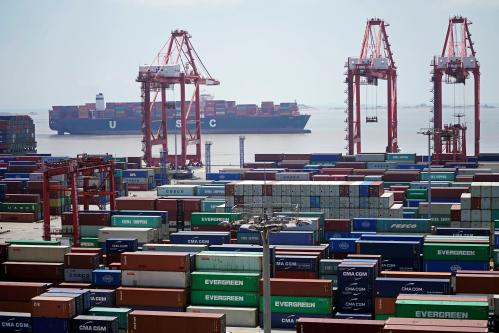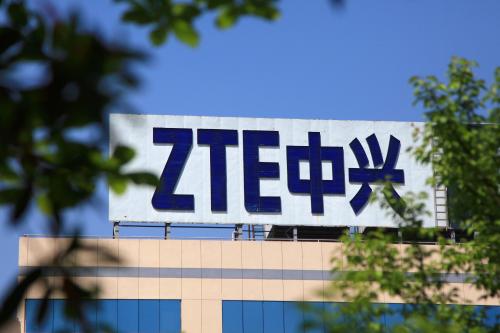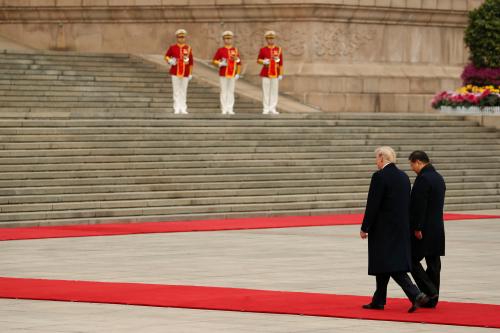China is betting that it can take a firm stand on North Korea and on trade and still have friendly relations with the Trump administration, writes David Dollar. The question for the United States is whether China’s gradual moves will be enough, or whether Trump instead will follow through on some of the protectionist ideas endorsed during the campaign. This piece originally appeared in The Hill.
Trump’s trip to China was largely about ceremony and the inking of deals. The administration announced more than $250 billion in deals. The total includes previous purchases such as Boeing aircraft as well as investments in both directions, many of which are non-binding memoranda of understanding.
The U.S. trade deficit with China is up 6 percent through September, and the overall goods and services deficit, up 9 percent. The deals are not likely to alter these macroeconomic trends.
Moreover, a tax cut in 2018 means lower U.S. national saving and thus a larger overall trade deficit. It is very likely that some of the wider trade imbalance will show up in the bilateral balance with China.
Aside from the ceremony and the deals, the primary purpose of the trip was to deliver firm messages in private on North Korea and on trade. On North Korea, Trump wanted to be seen publicly as aligned with Japan, South Korea, and China in a common front against the nuclear and missile programs.
Privately, he and his team are pushing China to do more, especially to cut off petroleum supplies to North Korea. China is reluctant to do this because its number 1 priority is to ensure that the regime does not collapse. It does not want millions of refugees or a unified Korea allied with the United States.
The action by Congress signals U.S. intent to get tough with Chinese banks.
Meanwhile, the Senate Banking Committee this week unanimously moved legislation that would mean steep penalties for Chinese banks aiding North Korea. China wants more time to allow recent sanctions to take effect and has urged the United States to talk to North Korea. The action by Congress signals U.S. intent to get tough with Chinese banks.
On trade, there was not much focus on market-opening moves either in preparation for the trip or during it. The deals do not represent changes in China’s trade and investment policy. U.S. firms continue to be unhappy about market access.
In autos, for example, China has a 25 percent import tariff and only allows foreign firms to invest via awkward joint ventures in which the U.S. firm has to transfer technology to its Chinese partner. There are many sectors in which China’s investment restrictions put U.S. firms at a disadvantage.
Financial services, telecom, social media, and transportation are all examples. Many of the deals announced, including in oil and gas, anticipate Chinese purchase of assets in the United States. The reciprocal deals, U.S. firms investing in China, would not be allowed under current law.
In public, President Trump said that he did not blame China for the state of the trade relationship; rather, he blamed his predecessors, Presidents Bush and Obama.
While the atmospherics were positive, in the background, the administration is conducting a Section 301 investigation of China’s unfair trade practices. The investigation is likely to document a range of unacceptable practices, including cyber theft and forced technology transfer.
Crunch time in the relationship will come six months or so down the road — the trade imbalance is likely to be widening and the administration, with the 301 investigation in hand, will have to decide if it wants to respond with some significant protectionist measures.
China, meanwhile, will probably make some opening moves in response to its own needs to generate more foreign investment and productivity growth now that the 19th Party Congress is over. These are likely to be partial and gradual.
An example came the day after Trump left: China announced that foreign firms in investment banking and insurance could have majority control in their joint ventures. During the Trump visit, President Xi said that China would open its market “according to its own timetable and roadmap” and called for each side to respect the other’s differences.
China is betting that it can take a firm stand on North Korea and on trade and still have friendly relations with the Trump administration. The question for the United States is whether China’s gradual moves will be enough, or whether Trump instead will follow through on some of the protectionist ideas endorsed during the campaign.







Commentary
Trump’s trade deals with China offer little new
November 13, 2017